
The Image Works Guide to fitting Motorcycle Stickers
Welcome to the "how to fit decals like a pro" page. The idea here is to show you some of the basic methods, tools and techniques we use and recommend, and also to dispel some of the myths about sticker fitting. While there is no magic way to fit stickers without bubbles there are a few methods you can use to reduce the number to almost nil, and when you get bubbles there are good ways and bad ways to get rid of them (more on this later)
There are a lot of "my mate says you do this......" or "I heard that if you do that....." stories told, most of which simply don't work. Having said that, there are hundreds of ways to do it, all I will show here are the ones we use. If you do it a different way and it works for you, great.
We do not supply fitting instructions with our sticker kits as many people have their own methods. Also one decal might need fitted in a completely different way on two different bikes. If you would like any advice about fitting your stickers, give us a call before you start, we will gladly talk you through it.
If fitting motorcycle stickers to new paintwork, we strongly recommend you allow at least 12 hours for the paint to dry before fitting. Even if the paint has been baked or feels "touch dry" there can be solvents trapped below the surface that will take time to migrate to the surface. If this occurs after you have fitted the decals it will blister them from behind causing hundreds of tiny bubbles which CANNOT BE REMOVED.
If you intend to lacquer over our motorcycle decals do not use any abrasives like Scotchbright pads etc. to key the surface of the decal, this will damage the printing. Do not use panel wipes that contain toluene as again, this will damage the printing. When applying the lacquer start off with a "dry coat" to seal the decals in, then build up the lacquer slowly, if you pile on heavy coats of lacquer too quickly you risk the solvents melting the vinyl .(this also applies when using OEM Motorcycle stickers)
Do a "dry run" first to plan out how the decal fits
Decide which method will work best before you start
Make sure you have all your tools to hand
Take your time
If in doubt, ask before your start. Advice is free, replacement motorcycle stickers cost money.
I will try to show a few methods for fitting a range of decals, from small individual stickers, to large "trim to fit" vinyls. Dry methods and wet methods. There are other methods that work just as well as these, but this is the way we do it.
Click the links below to:-
Specific kit guides
|
Swann-Morton scalpel or craft knife Number 10a or 11 blades 3M Blue Flexible squeegee (a filler spreader or old credit card will suffice ) |
Garden sprayer. Filled with water and 2 drops of washing up liquid
|
The "Little Chizler" Basically a cheaper version of the 3M Blue Flexible squeegee. But good for getting in to awkward places like air vents.
|
These are the basic tools you will need to do the job properly, all are available to buy from The Image Works, but most of them can be picked up at you local craft shop or motor factor.
The following "lesson" will show a good method for fitting decals that are pre-cut to the shape of the panel, the example shown is for the RSV Mille fairing side, but obviously the methods used will work for any similar decal. Before fitting any sticker, the panel must be perfectly clean and wax free. Any dust will show up as a pimple in the sticker which cannot be removed, as will any scratched paintwork. Much better to flat out any imperfections or scratches with a fine abrasive paper before you start.
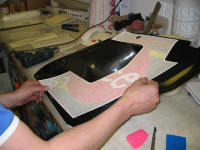
|
Before you start, trim the backing paper close to the edge of the decal, then offer the decal up to the panel and spend a moment to "get you head round it", look how it fits and make a mental note of the gaps at the edges and around vents etc. It's much easier to plan your fitting now than to change your mind half way through. It's often better to start in the middle if the panel has a pronounced curve, this will enable you to spread the excess vinyl around the whole edge of the decal rather than arrive at the end with a large ripple of vinyl and nowhere to fit it. However in this example the panel is reasonably flat so we are going to start fitting from the top. |
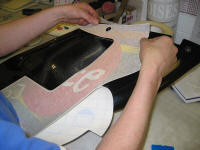 |
Peel back the backing paper from the part of the sticker where you intend to start, but leave the rest in place as this will prevent the decal sticking until you are ready for it. Carefully re-align the sticker with the edge of the panel, remembering how much space to leave at the edge from your dry run. Carefully press down the decal at the edge to hold it in place. |
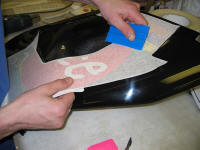 |
Using a flexible squeegee and firm pressure, work your way systematically and progressively along the decal, don't just rub randomly over the surface, this will cause air bubbles. Notice how the unfitted part of the decal is held slightly off the panel until it is pressed down with the squeegee. |
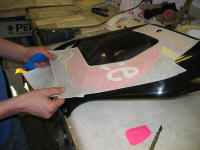 |
Continue along the decal in the same manner, peeling the backing away as you go, but leaving as little adhesive exposed as possible. This will help prevent dust particles sneaking in uninvited and spoiling the job. |
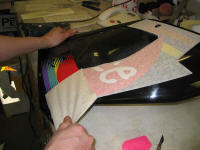 |
Once you have fitted the whole decal, peel the application tape off the front. Peel it back flat across the panel, not upwards. This will enable you to see if any or the edges or corners are not stuck down properly and also reduce the chance of tearing the decal off the panel. Remember that the adhesive on stickers is just like any other glue, and takes time to get maximum adhesion. If you have any bubbles, refer to lesson 6. |
This lesson will illustrate a good method for fitting large decals to fairing panels with air vents, mounting holes and across panels joints. We generally supply large decals complete, by that I mean we do not pre-cut the vents or mounting holes into the decals. The reason for this is it allows a bit more leeway when fitting. If the holes are all pre-cut into motorcycle stickers it means you have to be millimetre perfect when fitting, and even for a pro this can be difficult. I have used an HM Plant sticker being fitted to a Fireblade for this example but this method is also used when fitting other decals like Xerox Ducati or the Virgin Yamaha.
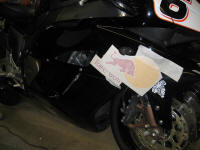 |
As always, plan ahead. Tape the smaller decals into their approximate positions. |
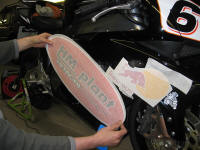 |
Perform a dry run to plan your tactics and get a clear picture in your mind or what the decal will look like when fitted. |
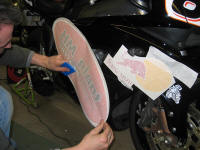 |
Remove the backing paper from the whole decal and using a flexible squeegee apply the decal to the flat surfaces, working around any vents or tight corners. Leave the sticker to hang loose over the edges and vents. |
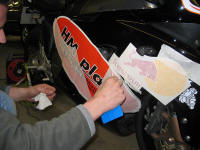 |
Carefully peel the application tape away from the sticker, making sure not to tear the decal. |
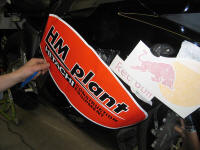 |
You should now have something that looks like this. The bulk of the decal is fitted and the vinyl just hangs over everything else. |
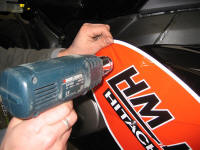 |
To aid flexibility, use a small amount of heat, this will allow the vinyl to curve around tighter bends. It can also be used to remove any slight creasing in the vinyl before you squeegee it down. |
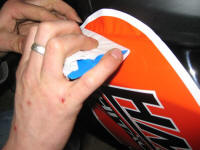 |
Take great care when working on the unprotected decal, it is a good idea to wrap a piece of soft cloth, or kitchen paper around the squeegee. |
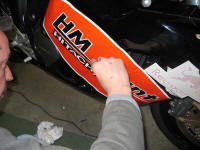 |
Using the scalpel, trim carefully around the mounting screws, this is done by putting the tip of the blade though the vinyl, into the hole and following the recess round. Not by cutting through the vinyl pressing against the paintwork. |
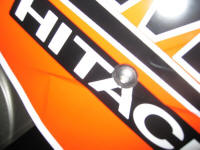 |
Like this ! |
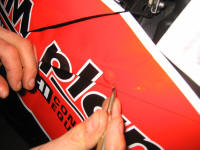 |
Run the blade along the join between the panels, and push the vinyl into the gap with the edge of the squeegee. |
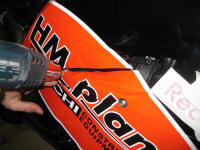 |
Run the blade along the mid line of the vent and using a little heat, (if it's only shallow, the heat from your finger is normally enough) work the vinyl progressively into the vent trimming off the excess as you go. |
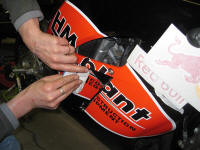 |
Repeat the above steps with all remaining vents and bumps |
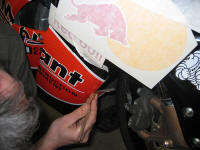 |
Using your fingers work the vinyl around the from edge and trim of along the the inside edge. If you have any bubbles, refer to lesson 6. |
OK, so you've mastered the basics, you've sussed how to fit big stickers and you can trim vinyl on the bike without damaging the paintwork? In that case it's time for the "biggie", the "this is as hard as it gets" bit, the bit where people will say "that's vinyl? you're kidding, it looks like it's been painted"
This method is used for a number of our more comprehensive kits. Bikes like the Xerox and Fila Ducati's, The Alice Aprilia and the Vimto Joey Dunlop SP-1. And the key to fitting it is the 6 P's rule..... Prior Preparation Prevents Pi$$ Poor Performance. I will show a couple of examples here, the Xerox belly pan (same method as Fila) and the Vimto seat unit The Vimto seat unit is pretty much as hard as it gets. If you can fit this, you can fit anything.....almost.
The Vimto Demon Joey Dunlop VTR SP-1seat unit
This is probably the method of fitting decals for which there are more myths, misconceptions and absolutely ridiculous stories told. I've heard of people soaking the decals in buckets of water, using neat washing up liquid, turps, and all manner of other liquids. All these methods will destroy your decals faster than dropping them in a shredder. There is only one solution we use at The Image Works and it's the cheapest, simplest, most abundant fluid on the planet. All you need is water, a garden sprayer and 2 drops of washing up liquid. The water will allow you more time to position the decals and make the fitting of large decals onto reasonably flat panels easier. The washing up liquid is only needed as it will break up the surface tension of the water, so that when you spray the water onto the panel you will get a fine mist of tiny water droplets. If neat water is used, large drops form which will run off the panel. The wet method is not suitable for all applications as it reduces the short term effect of the adhesive, making fitting decals to panels with a compound curve very difficult. It is also not suitable for fitting cut text decals as when removing the application tape it is very easy to tear the vinyl if part of the text has not yet adhered to the panel.
The most important thing to remember when using the wet method is be patient and take your time. This method cannot be rushed and it will take much longer to complete that fitting a dry decal. So with the scene set we can continue with lesson 4
Removing Bubbles and minor creases
If you've followed all the lessons above carefully, then hopefully you won't need this section. But hey, we all get the odd bubble or small crease. This section will arm you with the secret of invisible bubble removal, and it does not involve using a pin or needle (this is yet another myth that will result in ruined stickers) The tools needed are the scalpel, a brand new blade, a finger and for crease removal, a hot air gun. Now obviously we always get it right first time (yeah right) so rather than demonstrate on a customers bike we will use "The Image Works Cock-up simulator" which at first glance may look like a bit of scrap plastic. (you'd be surprised how difficult it is to deliberately get a bubble)